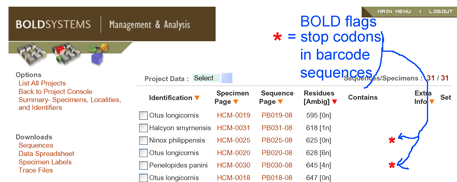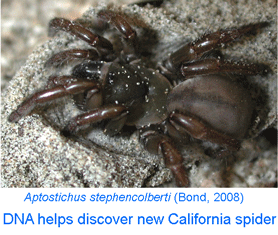 In August 2008 Sys Biol (open access!) researchers from East Carolina University apply mtDNA analysis as the necessary first step in defining three new species of trapdoor spider, previously subsumed as a single species Aptostichus atomarius. According to Bond and Stockman, “the genus Aptostichus is species rich, consisting of 30+ species (most undescribed) found predominantly throughout southern California.” I note that online World Spider Catalog version 9.0, 2008, lists four Aptostichus species, all described between 1891 and 1919, so apparently there is a lot of more work to be done, including updating the reference lists. One of the new names is A. stephencolberti, which led to what must be the first appearance of a spider taxonomist on national television (link to TV episode).
In August 2008 Sys Biol (open access!) researchers from East Carolina University apply mtDNA analysis as the necessary first step in defining three new species of trapdoor spider, previously subsumed as a single species Aptostichus atomarius. According to Bond and Stockman, “the genus Aptostichus is species rich, consisting of 30+ species (most undescribed) found predominantly throughout southern California.” I note that online World Spider Catalog version 9.0, 2008, lists four Aptostichus species, all described between 1891 and 1919, so apparently there is a lot of more work to be done, including updating the reference lists. One of the new names is A. stephencolberti, which led to what must be the first appearance of a spider taxonomist on national television (link to TV episode).
The authors describe the challenge for delimiting species in these California trapdoor spiders: “Highly structured, genetically-divergent, yet morphologically homogeneous species (eg nonvagile cryptic species[my note: nonvagile refers to organisms with limited dispersal]), although often ignored or overlooked, provide one of the greatest challenges to delimiting species. Populations, or very small groups of populations constitute diverent genetic lineages but present somewhat of a contradiction because they lack the “requisite” characteristics” often used when delimiting species. Morphological approaches to species delimitation in many of these groups grossly oversimplify and underestimate diversity; in short these traditional applications fail if our interests extend beyond what can simply be diagnosed with a visual and/or anthropormorphic-based assessment.”
So on the one hand, these spiders comprise multiple genetically distinct lineages (up to 24% sequence difference in 12S/16S mtDNA) with geographically restricted ranges; on the other hand, they all look more or less alike. How to decide which are species? The authors apply “cohesion species concept” by asking if the lineages are “genetically and/or ecologically interchangeable.” The authors provide helpfully provide explicit details of their decision making process. The short version is that genetically distinct, geographically disjunct lineages are counted as separate species, and parapatric or sympatric lineages are counted as different species only if they are NOT “ecologically interchangeable (EI).” EI is calculated from a defined set of ecological and climatic parameters.
Under some criteria, the authors note these spiders could be split into “more than 20” [or even] “~60” groups, which they describe as “an unreasonable number of species-level lineages.” This conjecture may be true; I hope that more scientists apply similarly explicit criteria for species delimitation as described here so we can learn more about how finely divided biodiversity is, in addition to our judgment about what is a “reasonable” number of species. Genetics is a powerful window into biology, of course. In birds the frequency of extra-pair matings (up to 96% pairs and 75% offspring in fairy wrens, for example (Double and Cockburn 2000)) was unsuspected until genetic testing was applied to parents and offspring.
The genetic framework in this study is based on 1300 bp of 12S/16S mtDNA (167 individuals, 75 locations), plus 905 bp nuclear ITS sequence in a subset of 22 individuals. Looking ahead, I hope that in their next study of spider phylogeography the authors include COI as an mtDNA locus (full-length sequence is 1500 bp, so that would likely have given the same phylogenetic signal as 12S/16S); this would enable the authors and others to combine their data with the reference COI DNA barcode databases.
I close with an observation about spider genetic data. To my eye, there are surprisingly few genetic data on spiders so far. A search in GenBank for Order Araneae (spiders) shows 9,445 sequences (representing any gene) from 1,852 species (4.6% world total of 40,432 species (World Spider Catalog)). Looking at mitochondrial genes, there are 2,629 COI sequences from 1,071 species (2.6% world) and 2,268 12S/16S sequences from 1,041 species (2.6% world). Thus it appears that only about 1/40th of world’s spiders have a uniform gene locus deposited in GenBank, and on average, only 2 individuals per species have been sequenced. The Spider Tree of Life project plans to sequence 50 loci (including COI and 12S/16S) from about 500 species, so that will help. I hope that arachnologists will follow the approach in this paper and include a standard genetic locus (most usefully COI) as part of species descriptions and analyze multiple individuals per species. Among other applications, this might help identify currently unidentifiable juvenile forms, like the wind-blown “little aeronaut[s]” that arrived on silk threads in vast numbers on the Beagle when it was sixty miles distant from land, November 1, 1832 (Voyage of the Beagle).
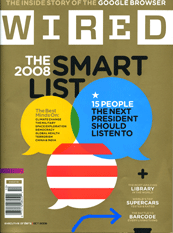 In
In 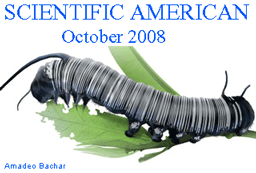 An article in
An article in 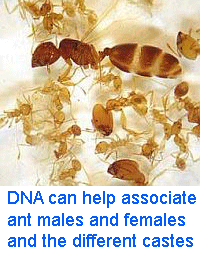 In
In 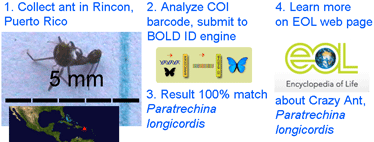 As a test of how DNA barcoding might work for the interested ant novice, I collected the tiny specimen at left in Rincon, Puerto Rico, and submitted its COI barcode to
As a test of how DNA barcoding might work for the interested ant novice, I collected the tiny specimen at left in Rincon, Puerto Rico, and submitted its COI barcode to 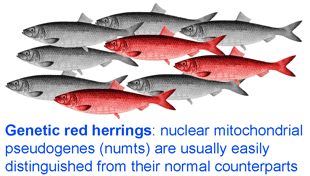 Pseudogenes, first described by
Pseudogenes, first described by 